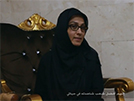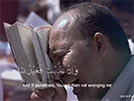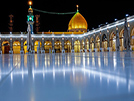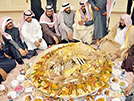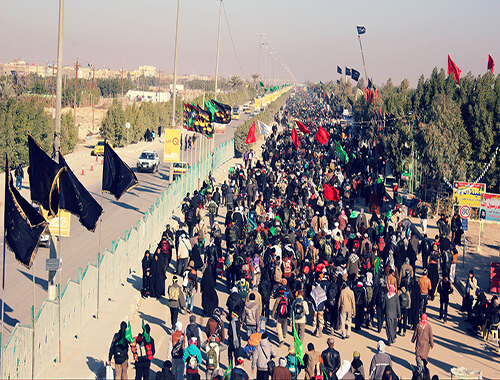'Kitab al-Irshad' by Al-Mufid
- Details
- Hits: 5335
Great Shi'i Works
'Kitab al-Irshad' by Al-Mufid
--------------------------------------------------------------------------------
Dr. I. K. A. Howard
Al-Serat, Vol. 3 (1977), No. 3
Al-Shaikh al-Mufid's full name was Muhammad b. Muhammad b. Nu'man al-Harithi al-Baghadi al-'Ukbari; his kunya was Abu 'Abd Allah. As well as being called al-Shaikh al-Mufid, he was known in both Shi'i and non-Shi'i circles as Ibn al-Mu'allim. He was born in the year 338 A.H./949 and was brought up in a village. His father brought him to Baghdad for his education. There he studied under Shi'i and Mu'tazili scholars. He showed such promise that one of his teachers recommended that he study under one of the leading scholars of the period, 'Ali b. 'Isa al-Ramani. He also studied under the leading Shi'i traditionists of the time, al-Shaikh al-Saduq. [1]
Al-Mufid lived during the period when the Buyids held political sway over Baghdad. They permitted much more tolerance towards the Shi'ites whether of Imami or Zaidi persuasion; they themselves were probably of Zaidi persuasion. As a result of this tolerant attitude, the Shi'ites were allowed to celebrate in public the Days of Ghadir Khumm (when the Prophet is said to have nominated 'Ali as his successor before the people) on 18th Dhu'l-Hijja, and 'Ashura, 10th Muharram (when al-Husain was killed at Karbala'). As a counter demonstration, some of the non-Shi'ites celebrated the Day of the Cave, (when the Prophet with Abu Bakr took refuge in a cave to escape the Quraysh who were pursuing them) on 26th Dhu'l-Hijja and also the day when Mus'ab ibn al-Zubair defeated al-Mukhtar b. Abi 'Ubaid on the 18th Muharram. [2]
It is said that al-Mufid earned his title of al-Mufid as a result of a dispute about the relative merits of the two events - Ghadir Khumm and the Cave. The story goes that when al-Mufid - Abu 'Abd Allah as he was - went to visit the scholar 'Ali b. 'Isa al-Ramani, mentioned above, there was a great crowd of people with the scholar. When the crowd grew thinner, the young Abu 'Abd Allah approached the scholar. However, then the arrival of a man from Basra was announced. The two, that is 'Ali b. 'Isa and his visitor from Basra, spoke for some time. Then the visitor asked 'Ali b. 'Isa what he had to say about the events of Ghadir Khumm and the Cave. 'Ali b. 'Isa replied:
"The tradition of the Cave is definite knowledge (diraya) while the tradition of Ghadir is (of the status) of a narration (riwaya). A narration (riwaya) does not require the same (acceptance) as definite knowledge (diraya)." The Basran could not find an answer to this and departed.
However, al-Mufid took up the discussion:
"O Shaykh, I have a problem," he said to 'Ali b. 'Isa.
"Put it forward, then," replied the latter.
"What would you say about someone who fought against a just Imam?" asked al-Mufid.
"He is an unbeliever (kafir)," was the answer. Then after a pause he changed it to "grave sinner (fasiq)."
"What do you say about the Commander of the Faithful, 'Ali b. Abi Talib?" . He was an Imam."
"What do you say about the Battle of the Camel, and some of the companions who fought against Ali b. Abi Talib." Therefore according to the above argument they should be described as fasiq, that is grave sinners who would go to hell. (However there is a tradition that these companions were among ten people whom the Prophet said would go to heaven. Thus 'Ali b. 'Isa has to explain how they could be fasiq and go to heaven. He does this in his next answer.)
"They repented."
"The tradition of the Battle of the Camel is definite knowledge (diraya) while the tradition of the repentance is a narration (riwaya)," replied al-Mufid.
Thus al-Mufid had turned the tables on him. The event of the cave was something all Muslims accepted as fact but there was no point in giving the well-reported tradition of Ghadir Khumm inferior status since if this was done the same terminology could be used to question the repentance of the said companions, which was also accepted by most Muslims.
'Ali b. 'Isa was very impressed by the young man's reasoning. He asked him about his teacher and then gave him a note to take to that man. In the note he recommended his intellect and gave him the nickname of al-Mufid, "the one who gives benefit". [3]
Al-Mufid soon became one of the foremost scholars of his time. He was an outstanding theologian and jurist, and a brilliant polemical writer on behalf of the Shi'ites. He became head of the Shi'i scholars in Baghdad and took part in many debates and discussions with his opponents.
As we have seen there was some rivalry between various groups during this period. This rivalry became much more tense during the time of the four rival days of remembrance which all came within four weeks of each other. Riots sometimes broke out and the authorities had to take firm action to restore the situation. After such a riot in 398 A.H./1007, al-Mufid was nearly exiled from Baghdad. However, in 410 A.H./1019, he was banished for a short time.[4]
During his life, al-Mufid was not only a brilliant debater and disputer he was a fine teacher and an outstanding and prolific writer As a teacher he will be remembered for the greatness of his three most outstanding pupils. They were the two 'Alids, al-Sharif al Radi and al Sharif al Murtada. Al Sharif al-Radi is perhaps best remembered as the compiler of many of Ali b. Abi Talib's speeches, sermons and letters Nahj al-balagha. His brother al Sharif al-Murtada was a brilliant theologian and an outstanding literateur. The other pupil was to become Shaikh al-Ta'ifa; he was Muhammad b. al-Hasan al-Tusi.
The writings of al-Shaikh al-Mufid were numerous. Al-Tusi tells us in the Fihrist that they numbered nearly two hundred. A number of these still survive; some have been published and some are still in manuscript form. Among them is al-Muqni'a, a work on tradition, which al-Tusi used as the basis for his great work Tahdhib al-ahkam fi sharh a/-munqi'a.[5] In theology, we are left with an important treatise Awa'il al-maqalat, where al-Mufid discusses Shi'i theology in relation to other schools; this work has been recently studied by a leading French scholar.[6] A working on the battle of the Camel, known as Kitab al-Jamal also survives. There is also Kitab al-Irshad which will be discussed later.
Al-Shaikh al-Mufid died in the month of Ramadan in the year 413 A.H./1022. One report says that over 80,000 people attended his funeral.[7] Al-Tusi himself reports that such a great crowd of mourners, both of opponents as well as friends, had not been seen before.[8] Al-Sharif al-Murtada led the funeral prayers and gave an eulogy. After being buried in his own house, his body was later removed and buried near to the great shrine of two of the Imams in Baghdad, known as al-Kazimayn. [9]
Kitab al-Irshad [10]
This book sets out to name the twelve Shi'i Imams. It briefly describes the circumstances of the Imamate of each Imam, the miracles that each performed by which he gave evidence of his Imamate, the virtues of each Imam, and the circumstances of the death of all the Imams and the disappearance of the last Imam. It also gives an outline of the nass, or the nomination of each Imam.
The Imamate of 'Ali b. Abi Talib after the Prophet is the cornerstone of the Shi'i view of succession and the Imamate in general. Therefore it is natural that the book should devote considerable space to 'Ali. Nearly half of the book is concerned with him. In particular al-Mufid pays great attention to 'Ali's career during the life of the Prophet. 'Ali is revealed as the person of outstanding merit during that period, the one who most deserved and was most entitled to succeed the Prophet. The reports of the traditions by which the Prophet is said to have made 'Ali's succession clear are fully reported, especially the tradition of Ghadir Khumm. In addition several of his speeches are given. Al-Mufid gives an account of some of 'Ali's legal decisions during the time of the three Caliphs, and he explains that 'Ali, although entitled to the office of the Caliphate, held back from attempting to seize the office or expressing public discontent. Little space is given to 'Ali's reign as Caliph, perhaps because these events had been discussed elsewhere by the author in Kitab al-Jamal for instance. The circumstances of 'Ali's murder by lbn Muljam are given in full and the author quotes from historical authorities, such as Abu Mikhnaf and Isma'il b. Rashid.
The Imamate of al-Hasan is described more briefly by the author. The martyrdom of al-Husain at Karbala' is given at some length. In this account al-Mufid tells us that he has relied on Abu Mikhnaf and Ibn al-Kalbi, who were also the main authorities of the historian al-Tabari for this event.
The other Imams are dealt with more briefly and in succession. The final Imam - the Qa'im, the Mahdi - is dealt with in more detail. The author gives the evidence of those who saw him. This is particularly important as doubt was expressed of his existence. He also refers to miracles performed by him; he tells of the prophecies about him and gives an account of what will happen when he returns.
Al-Irshad represents an important statement of Shi'i belief. It is written more as a defence of the Imami Shi'i view of the Imamate and it takes care to provide believers with the evidence of the Imamate. In establishing the Imamate of 'Ali, the doctrine of nass is shown by the author to be legitimate. Its legitimate use is carried on by 'Ali and his successors. In the author's view, the proof to the world of the Imamate of each of the Imams is expressed in the miracles performed by each Imam. Important moments in the lives of the Imams, such as the martyrdom of al-Husain and the ghaiba, the disappearance of the last Imam, are dealt with in some detail.
Al-Irshad was not the first work to be written on the subject. Al-Tabari, who died in the second half of the fourth century wrote two volumes on the Imamate; the first, al-Mustarshid, deals with 'Ali b. Abi Talib and the second Dala'il al-imama is an account of Fatima, and the other eleven Imams. However these two works are not as well-organised as al-Mufid's, nor do they make as much use of non-Shi'i sources as al-Mufid does.
Al-Irshad, then, represents a valuable contribution to the history of the Imamate, It has been written by one of the outstanding Imami Shi'i writers of his time and must be considered as one of the definitive Shi'i works on the history of the Imamate.
Notes:
1.On al-Shaikh al-Saduq cf. A-Serat Vol.II No.2, June, 1976, 19-22;
2.H. Laoust, "Les Agitations Religieuses a Baghdad" in Islamic Civilisation 950-1150 (ed. D. H. Richards) (Oxford 1973), 170.
3.Ibn Idris al-Hilli, Kitab aI-Sara'ir cited by al-Zanjani in his introduction to al-Mufid's Awa'il al-maqalat, (Tabriz, A.H. 1371).
4.Al-Tusi, a1-Fihrist (ed. Sprenger), new edition including indexes by Mahmoud Ramyar (Mashhad, A.H. 1351), 314.
5.Cf. Al-Serat, Vol. II No.3, September 1976, 23-25.
6.D. Sourdel, "L'Imamisme vu par le Cheikh al-Mufid", Revue des Etudes Islamique, XL, (Paris, 1972), 217-296.
7.D. Sourdel "Le Shaykh al-Mufid", Islamic Civilisation 950-1150, op. cit., 189, citing Ibn Abi Tayy.
8.Al-Tusi, op.cit., 315.
9.Al-Hilli, al-Idah at the foot of al-Tusi, op. cit., 316.
10.Kitab al-Irshad (ed. Al-Mayamawi) edition reproduced with additional notes by al-Akhundi, Teheran, A.H.1377.

